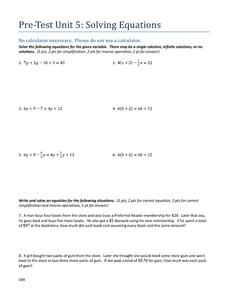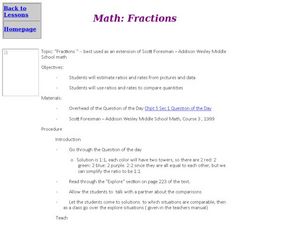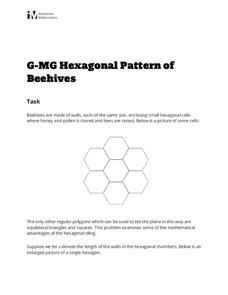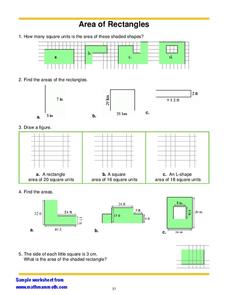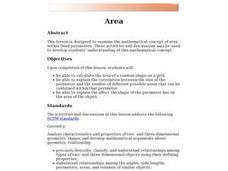Charleston School District
Pre-Test Unit 5: Solving Equations
Your pupils just may know more than you think they do! A pre-test assesses their ability to solve and write equations. It includes simple quadratic and cubic equations as well.
Curated OER
Calculate the Area of Shaded Squares
How can you find the area of a shape? Two shapes are provided on this simple worksheet which asks learners to find the area of the shapes. It's not as hard as it looks! You just have to count the squares! Before telling your pupils this...
Curated OER
Mixed Math Millionaire: Math Game
Play a game to review a variety of math concepts. Factoring, square roots, number sequences, division, multiplication, order of operations, and word problems are all covered in this Millionaire style quiz game. Tip: Keep this resource as...
Curated OER
My Test Book: Units of Measurement
In this math skills learning exercise, 5th graders solve 10 multiple choice math problems regarding units of measurement. Students may view the correct answers.
Virginia Department of Education
Exploring 3-D Geometry
Take young mathematicians on an exploration of the world of 3-D geometry with this seven-lesson unit. After first defining the terms perimeter, area, and volume and how they apply to the real world, students continue on to learn the...
Common Core Sheets
Rectangles - Same Area and Different Perimeter
Given a rectangle with specified dimensions, third graders are prompted to create a new rectangle with the same area, but a different perimeter. This challenges learners to think about perimeter and area in a new way. Use worksheet as a...
Curated OER
Explore Area: Practice
In this area worksheet, students estimate the are of each shaded figure using the square units. Students then answer two test prep questions about area.
Curated OER
Math: Fractions
Participate in a class lesson on ratio, rate, and unit rate. Successful usage of this lesson requires the pupils and the teacher have access to the Scott Foresman/Addison Wesley Middle School math text. However, the unit rate problems...
DK Publishing
Cubes of Small Numbers
Now that geometers know how to solve for square units, can they solve for cubed units? Explore this concept as scholars examine four cubes to solve for volume in each. A detailed example explains this process, but you may consider asking...
Illustrative Mathematics
Hexagonal Pattern of Beehives
Young geometers and biologists investigate the math of nature in an activity that is just the bee's knees. Participants will study the tessellations of hexagons in a beehive, along with the natural rationale behind the specific shape....
Curated OER
Developing an Understanding for Square Roots
For this algebra worksheet, students discover properties of squares while making squares with a Geoboard. There are two charts to complete and 15 questions.
Math Mammoth
Area of Rectangles
In this geometry worksheet, 4th graders identify how many square units is the area of each of the shaded shapes. Then they find the areas of the rectangles when the sides are given. Students also draw the figure described for each.
Curated OER
ExplorA-Pond: 4th Grade Perimeter Estimation
Your geometers are used to finding the perimeter of a square or rectangle, so give them something different this time! With this lesson, small groups will receive a picture of a shoreline and calculate the perimeter. The website listed...
Curated OER
Halves, Thirds, and Sixths
An excellent activity that effectively pulls together the concepts of area, fractions, and equivalent fractions! Using 3x2 rectangular arrays, 3rd graders are introduced to the concept of area in terms of square units. Building on this...
Charleston School District
Evaluation of Roots
You mean the square root of five and five don't have the same value? Learners estimate the value of irrational roots. As they practice estimating the value, they increase their understanding of roots. The lesson is the fourth in a series...
Curated OER
The Infinite Pine Tree
In this fractions worksheet, 6th graders solve and complete 7 different problems that include fractions. First, they identify and complete the denominator for the unit fractions in each of the squares shown on the sheet. Then, students...
New York City Department of Education
Chris’ Garden Dilemma
Make the connections between area, tiling, and multiplication. A performance task and associated unit presents the concept of area and makes the connection to multiplication. Pupils work through three major sections of instruction that...
Curated OER
Area of Squares Word Problems
Each of these rectangles is split into rows and columns. Can your scholars determine how many squares result? The 10 word problems have space for learners to draw the shape and split it up to answer the question. Remind them that they...
Curated OER
Area Applet
Elementary math classes calculate the area of a shape and explain the correlation between the size of the perimeter and the areas that can be contained within that perimeter. They also explain the effect the shape of the perimeter has on...
Curriculum Corner
8th Grade Math "I Can" Statement Posters
Clarify the Common Core standards for your eighth grade mathematicians with this series of classroom displays. By rewriting each standard as an achievable "I can" statement, these posters give students clear goals to work toward...
Curated OER
Math Activity File
Third graders describe the difference between area and volume and also explain how various units of measure relate to one another.
PBS
Arguing over Area
With the help of the Area Officers and Perimeter Patrol, you learners will develop a better understanding of area and its relationship to perimeter. First, they view a video clip from Cyberchase, and then they visit a website to test...
PBS
Garden Grade 6 Area and Perimeter
Engage young mathematicians in applying their knowledge of area and perimeter with a fun geometry lesson. Through a series of problem solving exercises, children use their math knowledge to design different-sized garden plots that meet...
Curated OER
Area is Always Flat, But It's Not Always Regular
Students calculate the area of regular and irregular polygons by counting the number of whole an half squares within the polygon. They determine the formula for regular polygons and label the area in square units.


